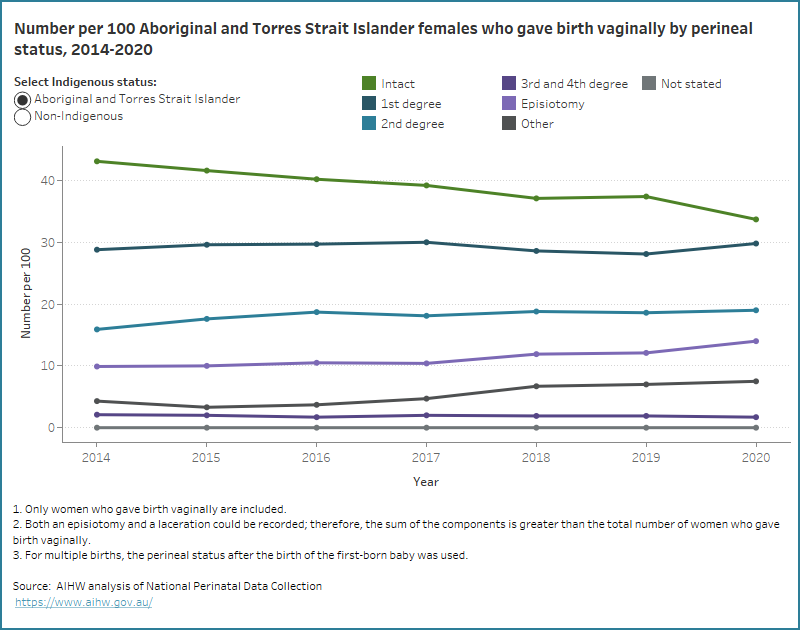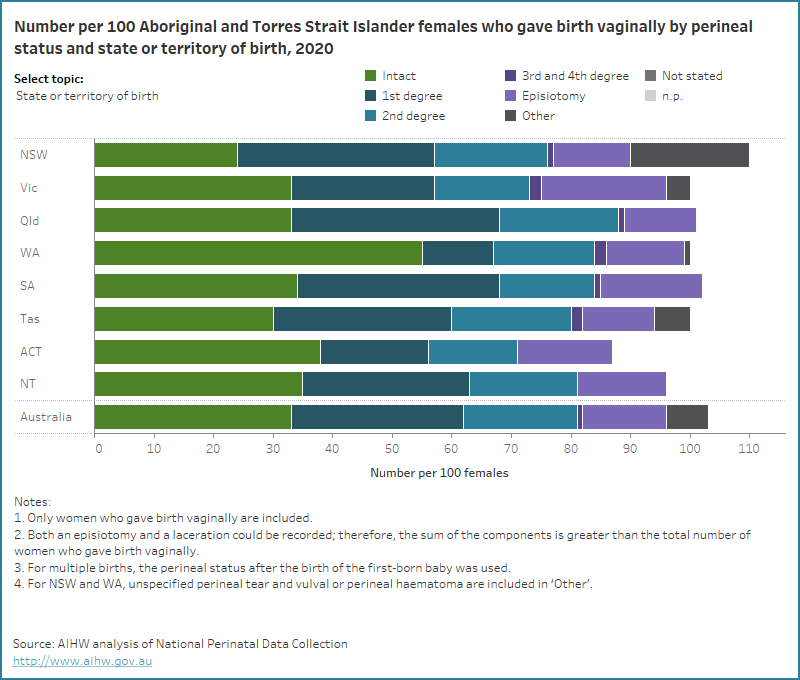 Perineal status
Perineal status
Perineal status refers to the state of the perineum after vaginal birth. Perineal status is categorised as intact, first degree laceration, second degree laceration, third or fourth degree laceration, episiotomy or other type of perineal laceration, rupture or tear. An episiotomy is an incision of the perineum and vagina to enlarge the vulval orifice to prevent perineal tears, particularly during instrumental vaginal birth (Homer and Wilson 2018).
Data are specific to women who gave birth vaginally and both an episiotomy and laceration can be recorded.
Many women who give birth vaginally experience perineal tears and recovery quickly (Homer and Wilson 2018). Third and fourth-degree tears, although uncommon, are severe and can have lifelong impacts – including pain, incontinence, and decreased quality of life – if not detected and repaired immediately after the birth (Homer and Wilson 2018).
In 2020, 34 per 100 Aboriginal and Torres Strait Islander females who gave birth vaginally had an intact perineum, 30 per 100 had a first degree tear, 19 per 100 had a second degree tear, 1.7 per 100 had third or fourth degree tear and 14 per 100 had an episiotomy (compared with 19 per 100, 22 per 100, 31 per 100, 2.9 per 100 and 26 per 100, respectively, for non-Indigenous females).
As perineal trauma is more common in primiparous women – and Aboriginal and Torres Strait Islander mothers have a higher parity than non-Indigenous women (for more information see Parity) – analysis of perineal status for Aboriginal and Torres Strait Islander and non-Indigenous females who gave birth vaginally in 2020 is presented below:
-
13 per 100 Aboriginal and Torres Strait Islander first-time mothers had an intact perineum, 24 per 100 had a first degree tear, 26 per 100 had a second degree tear, 3.6 per 100 had third or fourth degree tear and 33 per 100 had an episiotomy.
-
6.9 per 100 non-Indigenous first-time mothers had an intact perineum, 15 per 100 had a first degree tear, 31 per 100 had a second degree tear, 4.9 per 100 had third or fourth degree tear and 46 per 100 had an episiotomy.
Between 2014 and 2020, there has been a decrease in the rate of Aboriginal and Torres Strait Islander mothers with an intact perineum (from 43 per 100 in 2014 to 34 per 100 in 2020), and a corresponding increase in the rates having second degree tears (from 16 per 100 in 2014 to 19 per 100 in 2020) and episiotomy (from 9.9 per 100 in 2014 to 14 per 100 in 2020). The rates of third and fourth degree tears have remained relatively stable, ranging from 2.1 per 100 to 1.7 per 100.
The data visualisation below shows the proportion of Aboriginal and Torres Strait Islander and non-Indigenous females who gave birth vaginally by perineal status, from 2014.
Figure 1: Number per 100 Aboriginal and Torres Strait Islander females and non-Indigenous females who gave birth vaginally by perineal status from 2014 to 2020
Line graph of perineal status by Indigenous status. Aboriginal and Torres Strait Islander mothers having an episiotomy increased.

In 2020, Aboriginal and Torres Strait Islander females who gave birth vaginally were more likely to have an intact perineum if they were aged 40 years and over (49 per 100, compared with 19 per 100 of those aged under 20 years), had a parity of 4 or more (63 per 100, compared to 13 per 100 of first-time mothers) or had a non-instrumental vaginal birth (37 per 100, compared with 8.9 per 100 for instrumental vaginal birth).
Rates of episiotomy were higher for Aboriginal and Torres Strait Islander mothers who:
- lived in the least disadvantaged areas (20 per 100, compared with 13 per 100 for the most disadvantaged areas)
- were aged under 20 years (25 per 100, compared with 6.5 per 100 of those aged 40 years and over)
- were first-time mothers (33 per 100, compared with 0.7 per 100 for those with a parity of 4 or more)
- had induced labour (17 per 100, compared with 12 per 100 for spontaneous labour)
- had an instrumental vaginal birth (72 per 100, compared with 6.9 per 100 for non-instrumental vaginal birth).
The highest rates of third and fourth degree tears were seen for Aboriginal and Torres Strait Islander mothers aged under 20 years (3.2 per 100), first-time mothers (3.6 per 100) and those who had an instrumental vaginal birth (5.7 per 100).
The data visualisation below presents data on perineal status for Aboriginal and Torres Strait Islander females who gave birth vaginally, by selected maternal characteristics for 2020.
Figure 2: Number per 100 Aboriginal and Torres Strait Islander females who gave birth vaginally by perineal status and selected characteristics for 2020
Bar chart for perineal status by selected topics. 33 per 100 Aboriginal and Torres Strait Islander mothers had an intact perineum.

References
Homer C and Wilson A (2018) Perineal tears: a literature review, Australian Commission on Safety and Quality in Health Care, Sydney.


